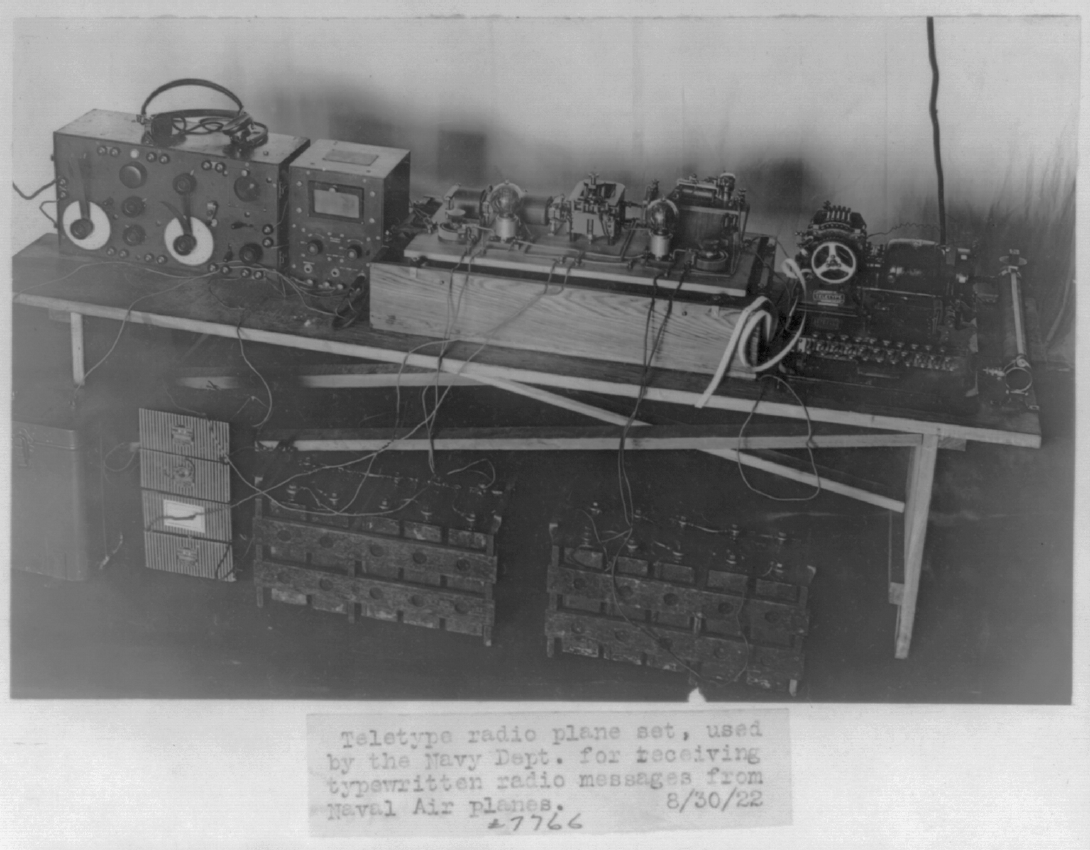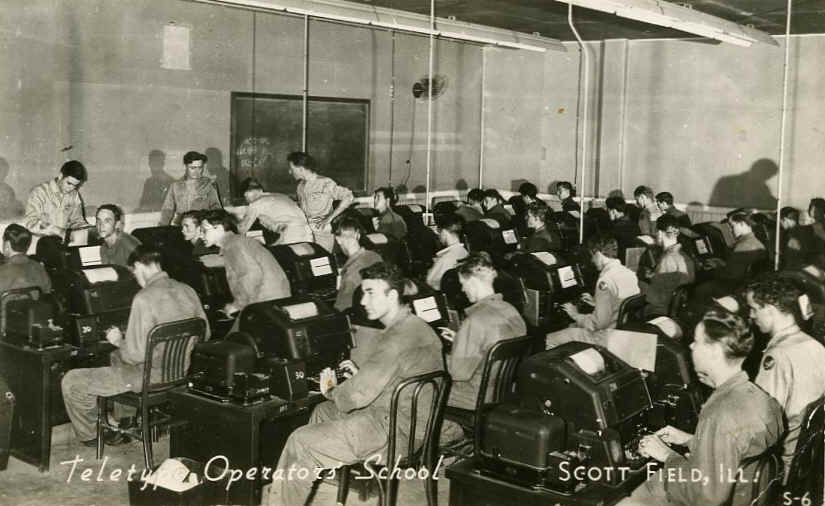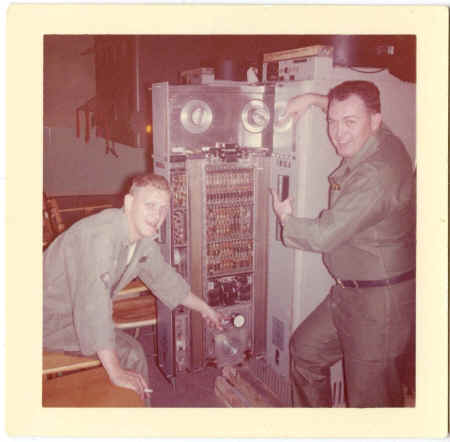|
Teletype Operator's School Scott Field 1950 |
| Minor comment on Signal Corps practices. Unlike USN, Signal
Corps equipment nameplates show the Order Number. A Signal Corps Contract
was a generic document that basically authorized a contractor to accept
Orders and get paid for them. The (usually) last two digits in the Order
Number are the last two digits of the Federal Fiscal Year. Which from the
first FD Roosevelt administration until the first Reagan administration
ran from 01 JULY of the previous calendar year to 30 JUNE of the year
listed. So if the Order Number is dated 1951, depending on lead times and
available stock on hand, the first deliveries could have been in the
second half of 1950. Especially if it was a re-order.
|
|
My 2 cents worth regarding the TT-4.....
The TT-4 (A) was a 1949 design. It really wasn't designed to replace the
Model 15s in
use at the time (TT-5), but was more or less accepted by the Army as it
was purpose-built
to be both "tactical" and "light weight", compared
to all the other clunkers available
at the time. This was predicated on the fact that the Army had
approached the Teletype
Corp to produce light weight equipment for use in the field by the Army.
Teletype Corp
said "no" to the proposal because their (then) current lines
of equipment were so
successful, both commercially and militarily, and their production lines
were at 100%
capacity (they had no more production capability and could not expand or
increase).
Note also that the Model 15/19 designs dated from the mid-1930s, and
likely the
Army wanted something a bit newer in the post WW II period. The Army
also wanted
something that was a "military" model, or at least
military-specific, since this was
going to eventually become a DoD-wide equipment-design system in years
to come.
A year or two after the TT-4 came out, Kleinschmidt brought out the
early model
of the TT-76 as a complimentary piece of equipment to go with the TT-4.
This
essentially replaced the Model 19s (TT-7s) iniatially in tactical
installs and later
in some fixed stations. The TT-4/TT-76 combinations worked pretty well
for the
Army, although, for some years, it was common to (still) see
combinations of
older Model 15 printers working with the newer TT-76s, or Model 14
reperfs working
with a TT-4, especially in later-era AN/GRC-26B RATT rigs.
(Prior to the introduction of the TT-76, there existed a Teletype Corp
perforator
(I don't recall its' designation or model number). This machine was
widely used
in field applications because it was light weight, small, and consisted
primarily
of a standard Teletype Corp Model 15 motor, standard Model 15 keyboard
and
a tape perforator.....and was used to simply cut tapes. There was no TD
or printer.
(We still had a few of these in Germany in the early 60s -- excellent
little machines).
Many of these older and newer machines were used in fixed CommCenters as
well, in all types of configurations and combinations.....
The Army however, was not entirely satisified with the TT-4/TT-76
machines for
fixed CommCenters. No one really knows why. A refined version was
produced.
We later knew it as the AN/FGC-25X, which was billed as a complete
"ASR" set
(unlike the TT-4/TT-76 which were separate components and not a
"set", and which
could be combined with other, older models of equipment).
It was the later TT-98 (TT-100) that actually replaced the Mod 15, and
as most of
us know, the TT-98 and TT-76 were "standard" configurations in
most tactical
assemblages in later years. Some fixed stations also used them, and
-unofficially-,
these combination machines were billed as AN /FGC-21s). (The real
AN/FGC-21
which did exist, was an entirely different machine using the same
components,
but also a mixer unit from a Model 19 for use with the PYTHON One-Time
tape
encryption system).
Dave
========================
Looking thru my "stuff" in regard to the early TT-4s, it is
likely the Army's bigger
need at the time was for a small, light weight printer for use in the
field in a time
before all of the factory-built comm shelters came into being.....
Recall that during WW II and thru most of the 1940s, teletypewriters
were used
mostly at Corps level and higher in the field, largely due to their
extreme weight
and bulk. Most of the equipment then in use was commercial-grade Model
15/19
gear. Such equipment did not lend itself well to either fast-moving
tactical units,
nor to the dust and dirt, and rough handling normally associated with
military
field duty. One must understand that the Army, especially during
training
maneuvers and exercises, always preferred the nastiest, harshest, most
undesirable climates, weather, and the like for troop training. The
assumption
here is that THAT was how real wars were likely to be fought anyway, and
both
the troops and their equipment had to stand up to it.
The concept of the field teletype probably started with the Army during
WW II.
The "field" teletype was usually set up in one of two
configurations:
a. a teletype machine(s) set up and operating in the back of a 2 1/2 ton
truck,
usually without a shelter or van assemblage. Most of these truck-mounted
teletypes were simply set up in the bed of the truck -- under the canvas
cover
of the truck itself with whatever electrical and signal lines running
from a ground
location to the equipment in the bed of the truck. Very primitive by the
standards
we got to know later on when factory-built shelters came into being.
b. a teletype, usually a Model 15 (printer) might also be set up the
same way,
but in a tent. Sometimes, more than one Model 15 might be in use at the
same
time ("different circuits").
Both of these set-ups were likely the forerunner of what later became
the
AN/PGC-1. The AN/PGC-1 was essentially a TT-4 printer, a wooden crate
that
it was packed in, and operating accessories (paper, ribbon, etc). Once
set up
in the field, the wood crate became the table on which the TT-4 was set
for
use. Not sure if the AN/PGC-1 included a Terminal Telegraph unit (TH-5)
which
would have served as an early, tube driven, "modem" of sorts.
Both the Army and the Marine Corps used the AN/PGC-1 in the field.
In these configurations, there were often no off-line tape prep
capabilities. Most
traffic processed might be 'received" from somewhere else, usually
higher HQ.
Any traffic that had to be "originated" was usually typed
online directly by the
op. The concept of the self-contained CommCenter had not yet been
developed.
Neither had the separation between "tactical CommCenters" and
"Radio Teletype"
operations, as both were more or less considered one and the same.
During the Korean War, things began to change. Shop-built shelters came
along
to house and operate this equipment. Most of these were made of wood and
looked
like huts placed on the back of a large truck. As time developed, the
huts were
refined for different types of uses by different types of units and by
the end of the
Korean War, several variations has been produced and were in regular use
by Signal
units.
So far as I know, the first mobile or tactical teletype shelters used by
the Army
were the highly successful AN/GRC-26A series and most of these were used
for
early HF RATT. These rigs were mounted on the bed of a 2 1/2 truck and
were
provided with a trailer-mounted 5 or 10KW generator for power which the
truck
pulled. Models of trucks varied over the years from the old G735 Diamond
Rios
to the late-date M-35A1s and 2s thru thye 1960s when the GRC-26s were
finally
phased out (culminating in the AN/GRC-26D which contained all
Kleinschmidt
teletype gear). All of the GRC-26-series shelters were of wood
construction, were
weather-proofed and held up well under heavy field use. A few later
models featured
some metal sides and roofing.
Along with the GRC-26s came other shelters, these being intended for
teletype
operations other than RATT. The most notable here was the AN/MSC-29
CommCenter van, which used the same prime-movers and generator sets as
the
26s, but which had considerably more teletype equipment installed (aboug
16 pieces
of Klineschmidt gear, 8 TT-4s and 8 TT-76s, plus the capability for
crypto gear,
Terminal Telegraph equipment, a field telephone switchboard (SB-22), a
small
safe, a small desk, operating accessories, patch panels, power hocks,
and
purpose-installed outside binding posts for various line and circuit
connnections.
The AN/MSC-29 was a unique piece of equipment in that is was designed
for
multi-purposes. At Division and Corps levels, it could be used as a
field tape
relay van, or it could be used as a terminal station. In any event, it
had a great
deal of capability and could support 4 full-duplex or 8 half duplex
encrypted
TTY circuits. Having worked in these vans extensively over the years,
they were
common equipment and "staples" of many signal units throughout
the US Army
for many years, including the Vietnam War years. As the need for
teletype service
and message traffic increased over the years in field units, it was
common to
see two (2) AN/MSC-29s set up back-to-back operating a large Signal
Center
at Division level, or in the case of an Army Corps, with as many as 28
of them lined
up in 2 rows, also back to back, operating a field Major Relay station
(i.e. as with
VII Corps, 34th Sig Bn in Europe).
I do not believe any other services operated the AN/MSC-29s.
Aside from the 29 vans, the Army had, over the years, developed many
other
teletype vans. Not far behind was the Air Force which developed its' own
line of
CommCenter vans (and the Air Force also used the AN/GRC-26Ds in the
early 50s
and 60s, but theirs were usually mounted on an International Harvester
commercial
truck bed, in a day long before the ground-mobile "mobilizers"
came along.
I can find no record of the Marine Corps ever using the larger
Army-style vans.
Likely, these would not have been practical for an assault force on the
move,
but they worked fine for a slower-moving occupational force, or for
units in
semi-fixed (static) situtations in a field or fixed environment.
Hope this info is helpful,
Dave
Kleinschmidt manuals available at http://rattrig.com/manuals/tm%27s.htm
|
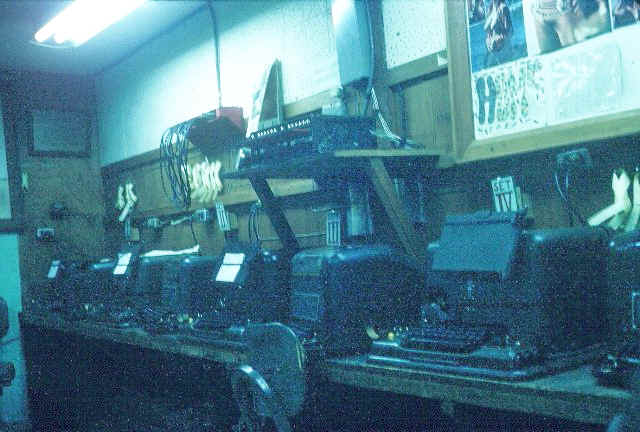
Our country-wide commcen at Long Binh, Vietnam used the TT-4s and
TT-76s exclusively. We had four land-line This photo was taken in 1971 at Long Binh, RVN.
This commcen supported HHC, 1st Aviation Brigade. we used KW-7s with
the plugblock version. See: http://www.jproc.ca/crypto/kw7.html
for detail on the KW7 if you are not familiar, or just want to re-aquaint
with this crypto system. . |
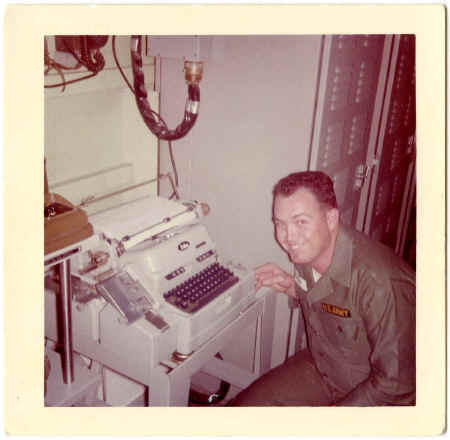
|
| 1978
ECI E-Systems T-1148 Military Impact Teleprinter Print Ad
|
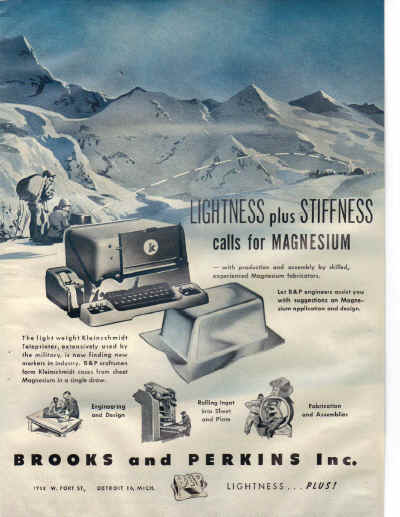
|
